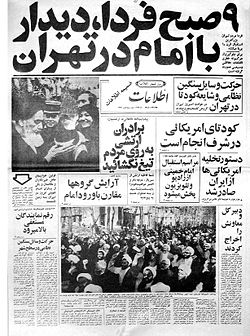
| History of the Iranian revolution |
|---|
 |


Ruhollah Khomeini’s return to Iran on 1 February 1979, after 14 years in exile, was an important event in the Iranian Revolution. It led to the collapse of the provisional government of Shapour Bakhtiar and the final overthrow of the Shah of Iran, Mohammad Reza Pahlavi, on 11 February 1979.
Ruhollah Khomeini, known in the Western world as Ayatollah Khomeini,[1] was an Iranian Shia Muslim religious leader, philosopher, revolutionary and politician.[2] Prior to his exile, Khomeini had been a prominent opponent of the Shah. Upon his return, he was greeted by crowds of millions, and within 10 days the revolution would be successful. Following the revolution, Khomeini became the country's Supreme Leader, a position created in the Constitution of the Islamic Republic of Iran as the highest-ranking political and religious authority of the nation, which he held until his death. Khomeini's return and the 10 days following are now celebrated in Iran as the Fajr decade.
- ^ "Ayatollah Khomeini (1900–1989)". BBC – History. Retrieved 20 June 2013.
- ^ "Ayatollah Khomeini (1900–1989)". BBC – History. Retrieved 20 June 2013.